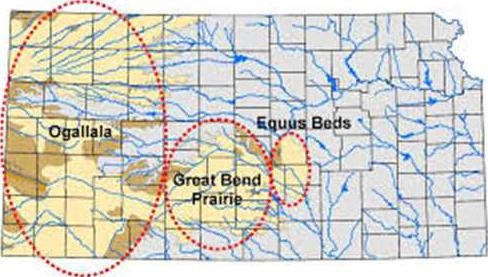Kansas State University geology professor Dr. Matthew Kirk and a team of undergraduate students (including some from Barton Community College) have spent the past year analyzing private water wells in Barton County. Among their findings – elevated nitrate levels.
They presented what they’ve learned during a public meeting Friday afternoon at the BCC Library. This was in preparation for a public forum on broader water issues from 5:30-7 p.m. Tuesday, Nov. 7, at the Great Bend Events Center, and further discussion from 9 a.m. to 10 a.m. on Wednesday, Nov. 8, at the Kansas Wetlands Education Center.
“We want to spread awareness of good water practices for locals, the region, and for generations to come,” said Kirk, head of the Kirk Groundwater Research Group. This is part of Kansas Groundwater GEOPAths, an undergraduate research program formed through collaboration between Barton and Dodge City community colleges and K-State, and funded through the National Science Foundation and the KSU Geology Department.
“As far as water quality findings are concerned, the main issue we have encountered is high nitrate,” Kirk said. “Nearly half of the wells we have sampled produce groundwater with nitrate levels that are considered to be unsafe for human consumption.”
He is referring to the U.S. Environmental Protection Agency’s maximum contaminant level for public water supplies (10 milligrams per liter). “That regulatory limit does not apply to private wells, but it does provide a frame of reference for what is considered to be safe,” he said.
Aside from nitrate, many of the samples they collected have high hardness and overall solute levels, though those characteristics are not significant health concerns, he said.
Although they are still awaiting the testing results from their samples (more than 90 from Barton and surrounding counties), past results demonstrated the main source of nitrate was nitrogen-based fertilizers.
According to Kirk, high nitrate levels in drinking water can cause human and livestock health issues by interfering with transport of oxygen by blood and possibly causing a higher risk of cancer. Too much nitrate in groundwater can also stimulate a release of uranium and selenium from the sediment into the water.
Why Barton County?
“For our project, we are trying to span the full extent of the Great Bend Prairie Aquifer,” he said. The 6,769-square-mile aquifer covers all or parts of 11 central and western Kansas counties, including Barton, which was a focus this year with their presentation being here.
“We are interested in the aquifer because our past work showed that nitrate levels have risen sharply in there during the past 40 years,” he said. That was the conclusion of a multi-year K-State study that ended in 2020 of which Kirk was a part working Big Bend Groundwater Management District No. 5.
“We selected wells largely at random,” Kirk said. “We used rural directories to find contact information for people living in each county and made phone calls to see if they were willing to let us sample.”
In selecting well owners to call, they attempted to spread them out across each county. In addition, they also included some wells that are owned by parents or family friends of student participants in the program.
“We will be doing additional sampling each of the next two falls. For each sampling trip, we will have the time and funds available to collect about 30 to 40 samples,” he said. They expect that those efforts will mostly focus on the southern half of the aquifer, where they currently have little data.
“This is the first year of the project and we currently have funding for two more years,” he said. “We expect to engage about the same numbers of students each year.”
Next year, they will likely focus sampling efforts on Edwards, Kiowa, Pratt and Reno counties. “In year, three, we will likely look to fill in any areas we missed in years one and two,” he said.
What is GEOPAth?
The initiative promotes geo-science career paths in Earth, Ocean, Polar and Atmospheric sciences (GEOPAths). The GEOPAths effort invites proposals that specifically address the current needs and opportunities related to education, learning, training and professional development, like the work of Kirk’s program.
“Our project has a few goals,” he said. “First, our main goal is to introduce students to environmental geo-science and provide them with career-relevant training.”
And, “secondly, through the student’s efforts, we hope to help residents of south-central Kansas learn about the quality of their water.”
They sampled and analyzed property owners’ groundwater and will them with a water quality report.
“Related to the first objective, the project includes 19 undergraduate students (seven from BCC, four from DCCC and eight from KSU),” he said. “The project teams these students up, introduces them to groundwater science and provides career and transfer mentoring, a research experience, and the opportunity for them to give back to their communities.”
Educators hope this experience increases their interest in geo-science “because we need more geo-scientists,” he said. “In many geo-science programs around the world, enrollment is down. However, workforce demand is high because geo-scientists are essential to sustaining population growth and meeting some major challenges, including challenges in water, energy, and mineral resources.”





